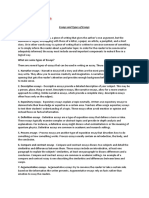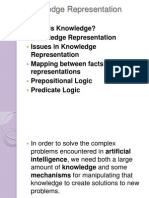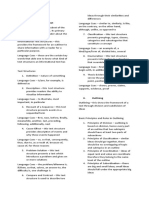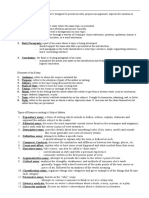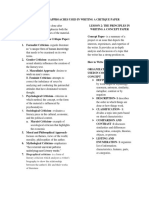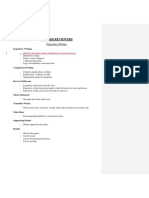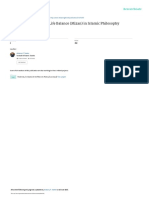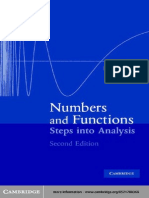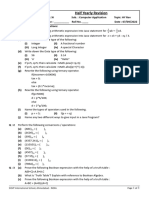0 ratings0% found this document useful (0 votes)
25 viewsEnfocad Rebyuwer
Enfocad Rebyuwer
Uploaded by
Sheila Ann Mae GabayThe document provides guidance on writing different types of academic papers including reaction papers, review papers, critique papers, and position papers. It outlines the key sections and focuses for each paper type. Reaction papers allow sharing thoughts on something read and involve prewriting, determining a thesis, and organizing a response. Review papers summarize recent work on a topic through sections on the abstract, introduction, body, and conclusion. Critique papers briefly summarize and critically evaluate a work using approaches like formalism, feminism, or media criticism. Position papers generate support for an issue by describing a position, rationale, and facts to argue the division of opinions on a contested topic.
Copyright:
© All Rights Reserved
Available Formats
Download as DOCX, PDF, TXT or read online from Scribd
Enfocad Rebyuwer
Enfocad Rebyuwer
Uploaded by
Sheila Ann Mae Gabay0 ratings0% found this document useful (0 votes)
25 views7 pagesThe document provides guidance on writing different types of academic papers including reaction papers, review papers, critique papers, and position papers. It outlines the key sections and focuses for each paper type. Reaction papers allow sharing thoughts on something read and involve prewriting, determining a thesis, and organizing a response. Review papers summarize recent work on a topic through sections on the abstract, introduction, body, and conclusion. Critique papers briefly summarize and critically evaluate a work using approaches like formalism, feminism, or media criticism. Position papers generate support for an issue by describing a position, rationale, and facts to argue the division of opinions on a contested topic.
Original Title
ENFOCAD-REBYUWER
Copyright
© © All Rights Reserved
Available Formats
DOCX, PDF, TXT or read online from Scribd
Share this document
Did you find this document useful?
Is this content inappropriate?
The document provides guidance on writing different types of academic papers including reaction papers, review papers, critique papers, and position papers. It outlines the key sections and focuses for each paper type. Reaction papers allow sharing thoughts on something read and involve prewriting, determining a thesis, and organizing a response. Review papers summarize recent work on a topic through sections on the abstract, introduction, body, and conclusion. Critique papers briefly summarize and critically evaluate a work using approaches like formalism, feminism, or media criticism. Position papers generate support for an issue by describing a position, rationale, and facts to argue the division of opinions on a contested topic.
Copyright:
© All Rights Reserved
Available Formats
Download as DOCX, PDF, TXT or read online from Scribd
Download as docx, pdf, or txt
0 ratings0% found this document useful (0 votes)
25 views7 pagesEnfocad Rebyuwer
Enfocad Rebyuwer
Uploaded by
Sheila Ann Mae GabayThe document provides guidance on writing different types of academic papers including reaction papers, review papers, critique papers, and position papers. It outlines the key sections and focuses for each paper type. Reaction papers allow sharing thoughts on something read and involve prewriting, determining a thesis, and organizing a response. Review papers summarize recent work on a topic through sections on the abstract, introduction, body, and conclusion. Critique papers briefly summarize and critically evaluate a work using approaches like formalism, feminism, or media criticism. Position papers generate support for an issue by describing a position, rationale, and facts to argue the division of opinions on a contested topic.
Copyright:
© All Rights Reserved
Available Formats
Download as DOCX, PDF, TXT or read online from Scribd
Download as docx, pdf, or txt
You are on page 1of 7
Enfocad Reviewer of the text.
Otherwise, you are
just summarizing what you read.
Lesson 8: Reaction Paper
8. Determine your thesis - This
Reaction Paper - is a form of is the core of your reaction paper.
academic writing that allows the Take all your points, opinions,
writer to share their thoughts and and observations, and combine
ideas on what they have seen or them into one claim that you will
read. prove
How to Write a Reaction 9. Organize your paper - It
Paper? needs an introduction, body
1. Prewriting and Actively paragraphs, and a conclusion.
Reading - understand the 10. Gather quotations - find
purpose of a reaction paper. quotations or statements that will
2. Figure out what the support your points.
assignment is asking - figure out 11. Structure your paragraphs
exactly what your teacher or - Your paragraphs should always
professor is looking for. start with a topic sentence. You
3. Read the text you are can start with what the author
assigned right after it is says and follow that with your
assigned - A reaction paper is a reaction.
process of exploring the texts, 12. Keep it short - The topic
which means you take the sentence should put forward your
information you read and bring it intention without forcing your
together so you can analyze and reader to hunt it down; keeping it
evaluate. short will help keep your
4. Annotate the text as you intention clear.
read - Annotating in the margins 13. Avoid introducing yourself
of the text allows you to easily - Never use statements such as;
locate quotations, plot lines, “I am going to tell you…” or
character development, or “My paper is about…” or “I
reactions to the text. studied [this] which is important
5. Question as you read - This is because of [this]”.
where your evaluation of the 14. Avoid starting with a
material and your reaction begins quotation - The topic sentence
6. Free write - Write your should introduce the paragraph
reactions and evaluations of the and include your opinion, not
author's ideas. someone else’s. If the quote is
opinion-based, substitute it for
7. Decide on your angle -
your own opinion.
Reaction papers have to be
critical and have some evaluation Lesson 9: Review Paper
Review Paper/ Literature Rev -write the thesis statement
-the purpose of it is to succinctly Body or Discussion
review recent progress in a -experimental evidence. Explain
particular topic. the data and point out any
-the paper summarizes the controversies in the field
current state of knowledge of the - use figures or tables to show
topic key data
-provides background info., to Conclusion
establish importance,
demonstrate reliability, and carve -summarize major points but
out a space for further addition to keep them brief.
research. -point out the significance of
Review P. vs. Research P. these results.
The review paper does not -discuss the questions that remain
describe the original research in the area.
conducted by the author(s). References
Research Paper, on the other
hand, contains original research -the instructor will give min.
work by the author. num. of references, but typically
8-10 ref.
Sections of a Review Paper
-APA 7th edition
Abstract
-a contextual sentence about your
motivation behind your research
topic
-your thesis statements
-a descriptive statement about the
types of lit. used in the review
-summarize your findings
-conclusion(s) based upon your
findings
Introduction
-brief (1/5 of the paper)
-grab the reader’s interest
-explain the “big picture”
relevance
- provide background info
Lesson 10: Critique Paper psychological, and economic
oppression
Critique - is a genre of academic
writing that briefly summarizes and -Are the male characters powerful
critically evaluates a work or or superior in their position while
concept. the female characters are
subordinate or inferior?
They analyze this kind of works
Marxism - concerned with the
Creative Works – novels, exhibits, difference between economic
films, images classes. Attempts to reveal that the
Research – monographs, journal ultimate source of people’s
articles, reviews, experiences is the socioeconomic
system.
Media – news reports, feature
articles -Focus on how class, power, race,
and economic status affect the
Critical approaches in writing a
content and theme of a certain work
Critique
New Historicism - posits that
New Criticism (Formalism) -
every literary work is the product
claims that literary works have
of its time and world. As the means
intrinsic properties and treats each
to understand cultural and
work as a distinct work of art.
intellectual history.
-Elements of a story character,
-Focus on the era and significant
setting, conflict, etc. Poem (meter,
events that happened during the
figurative devices, imagery, theme)
time the text (or any other art) was
Movies (sound effects, transitions,
produced.
shots)
-How did Juan Luna’s spolarium
-We use the formalism to determine
depict the happenings during the
the meaning by focusing on literary
time it was painted?
Reader Response - is concerned
Media Criticism - dissect a
with the reviewer’s reaction as an
popular film and other forms to
audience of a literary work
explain to a broad audience how, in
-Claims that the reader’s role academic terms, these cultural
cannot be separated from the artifacts can be reflective of social
understanding of the work issues, evidence artistic
-Claims that a text does not have accomplishment, offer a critical
meaning until the reader reads and voice to power, and much more
interprets it -Often taking the form of a visual
-This criticism is focused on the essay, the media critique requires
message of the text editorializing and translating both
written and visual source materials
Feminism - focuses on how into an understandable whole
literature presents women as
subjects of socio-political,
Lesson 11: Position Paper 5. Stating Your Thesis - an
assertion about your topic,
Position Paper - an essay or
something you claim to be true
report which expresses a
position, conclusion, or 6. Writing with Style and
recommendation concerning a Clarity – you should have good:
Diction – refers to the choice of
contested issue or undecided
words for the expression of ideas
question.
Paragraphs – developing and
- The purpose of a position
framing an idea or impression.
paper is to generate support for As a general rule, you should
an issue. It describes a position address only one major idea per
on an issue and the rationale for paragraph
that position. It is based on facts
Transition – provide the reader
that provide a solid foundation
with directions for how to piece
for your arguments.
together your ideas into a
Techniques for Writing a logically coherent argument.
Position Paper
1. Issue Criteria - Choose an
issue where there is a clear
division of opinion and which is
arguable with facts and inductive
reasoning
2. Analyzing an Issue and
Developing an Argument
Grammar and Spelling –
Mechanical errors are usually the
main reason for lack of clarity in
essays, so be sure to thoroughly
proofread your paper before
handing it in.
3. Considering your audience Plagiarism and Academic
and determining your Honesty - is a form of stealing;
viewpoint – is your topic as with other offences against the
interesting? law, ignorance is no excuse. The
4. Organization – introduction, way to avoid plagiarism is to
body & conclusion give credit where credit is due.
Lesson 12: Logical Fallacies supporting controversial
legislation or policies.
Logical Fallacy
Slippery Slope - assumes that a
-Logical fallacies are flawed,
certain course of action will
deceptive, or false arguments that
necessarily lead to a chain of
can be proven wrong with
future events. The slippery slope
reasoning.
fallacy takes a benign premise or
-Fallacies are common errors in starting point and suggests that it
reasoning that will undermine the will lead to unlikely or ridiculous
logic of your argument. outcomes with no supporting
-Fallacies can be either evidence.
illegitimate arguments or Straw Man - attacks a different
irrelevant points and are often subject rather than the topic
identified because they lack being discussed — often a more
evidence that supports their extreme version of the
claim. counterargument. The purpose of
-Avoid these common fallacies in this misdirection is to make one's
your own arguments. position look stronger than it is.
Types of Logical Fallacy Circular Arguments - occur
when a person's argument repeats
Ad Hominem - uses personal what they already assumed
attacks rather than logic. This before without arriving at a new
fallacy occurs when someone conclusion.
rejects or criticizes another point
of view based on the personal Hasty Generalization - a claim
characteristics, ethnic based on a few examples rather
background, physical than substantial proof.
appearance, or other non-relevant Arguments based on hasty
traits of the person who holds it. generalizations often don't hold
up due to a lack of supporting
Appeal to Ignorance - argues evidence: The claim might be
that a proposition must be true true in one case, but that doesn't
because it has not been proven mean it's always true.
false or there is no evidence
against it. Red Herring - an argument that
uses confusion or distraction to
False Dilemma/False shift attention away from a topic
Dichotomy - is a manipulative and toward a false conclusion.
tool designed to polarize the Red herrings usually contain an
audience, promoting one side and unimportant fact, idea, or event
demonizing another. It's common that has little relevance to the real
in political discourse as a way of issue.
strong-arming the public into
Appeal to Hypocrisy - also or mislead. In other words,
known as the tu quoque fallacy saying one thing but meaning
— focuses on the hypocrisy of an another.
opponent. The tu quoque fallacy Appeal to Pity - relies on
deflects criticism away from provoking your emotions to win
oneself by accusing the other an argument rather than factual
person of the same problem or evidence. Appealing to pity
something comparable. attempts to pull on an audience's
- an attempt to divert blame. The heartstrings, distract them, and
fallacy usually occurs when the support their point of view.
arguer uses apparent hypocrisy to - Someone accused of a crime
neutralize criticism and distract using a cane or walker to appear
from the issue. feebler in front of a jury is one
Causal Fallacies - are informal example of appeal to pity. The
fallacies that occur when an appearance of disability isn't an
argument incorrectly concludes argument on the merits of the
that a cause is related to an case, but it's intended to sway the
effect. Think of the causal fallacy jury's opinion anyway.
as a parent category for other Bandwagon Fallacy - assumes
fallacies about unproven causes. something is true (or right or
Sunk Cost - is when someone good) because others agree with
continues doing something it. In other words, the fallacy
because of the effort they already argues that if everyone thinks a
put in it, regardless of whether certain way, then you should,
the additional costs outweigh the too.
potential benefits. "Sunk cost" is -One problem with this kind of
an economic term for any past reasoning is that the broad
expenses that can no longer be acceptance of a claim or action
recovered. doesn't mean that it's factually
Appeal to Authority - is the justified. People can be mistaken,
misuse of an authority's opinion confused, deceived, or even
to support an argument. While an willfully irrational in their
authority's opinion can represent opinions, so using them to make
evidence and data, it becomes a an argument is flawed.
fallacy if their expertise or
authority is overstated,
illegitimate, or irrelevant to the
topic.
Equivocation - happens when a
word, phrase, or sentence is used
deliberately to confuse, deceive,
You might also like
- 10 Types of EssaysDocument2 pages10 Types of EssaysJoseph Allan Ferriols0% (1)
- EAPP REVIEWER (2nd QTR Test)Document5 pagesEAPP REVIEWER (2nd QTR Test)Racquel Decena0% (2)
- Knowledge Representation in Artificial IntelligenceDocument19 pagesKnowledge Representation in Artificial IntelligenceSweeti Sah100% (5)
- Maslow's Hierarchy How The "House of Cards" CrumblesDocument66 pagesMaslow's Hierarchy How The "House of Cards" Crumblesken jacobsenNo ratings yet
- EAPPDocument5 pagesEAPPTayag, Jayna Xzyha G.No ratings yet
- EAAP ReviewerDocument6 pagesEAAP ReviewerAtasha FilipinaNo ratings yet
- EAPP REVIEWER Part 1Document6 pagesEAPP REVIEWER Part 1Haydee TerronesNo ratings yet
- Eapp ReviewerDocument14 pagesEapp ReviewerHeaven Krysthel Bless R. SacsacNo ratings yet
- Eapp ReviewerDocument1 pageEapp ReviewerAs AsNo ratings yet
- Eapp ReviewerDocument1 pageEapp ReviewerAs AsNo ratings yet
- EAPP MidtermreviewerDocument5 pagesEAPP MidtermreviewerFiery RoseyNo ratings yet
- My Eapp NotesDocument5 pagesMy Eapp NotesKareen TanNo ratings yet
- Text 1 Text 2Document32 pagesText 1 Text 2Jethro Briza GaneloNo ratings yet
- Eapp Summary of Lessons For Quarter 1Document2 pagesEapp Summary of Lessons For Quarter 1Mart ZedrickNo ratings yet
- Reviewer in EappDocument5 pagesReviewer in EappJenny ChinNo ratings yet
- EAPP ReviewerDocument7 pagesEAPP Reviewerbepaca6152No ratings yet
- English 10 1Document13 pagesEnglish 10 1Shane RonarioNo ratings yet
- Pointers For EAPP First Quarter ExamDocument6 pagesPointers For EAPP First Quarter ExamMary Grace Sagun90% (10)
- English For Academic and Proffessional PurposesDocument4 pagesEnglish For Academic and Proffessional PurposesJewel ValenciaNo ratings yet
- 1st Quarter Eapp ReviewerDocument2 pages1st Quarter Eapp ReviewerVivien Lancin100% (1)
- EAPPReviewerDocument3 pagesEAPPReviewerNikolai NoveroNo ratings yet
- PDF 20220922 100338 0000Document19 pagesPDF 20220922 100338 0000Khiane Audrey GametNo ratings yet
- EAPP Pointers REVIEWER 1Document9 pagesEAPP Pointers REVIEWER 1jamjam laurioNo ratings yet
- Reading and Writing ReviewerDocument5 pagesReading and Writing ReviewerDion Alexander VillagarciaNo ratings yet
- Reviewer in EappDocument4 pagesReviewer in EappTCHR KIMNo ratings yet
- English (First Quarter)Document5 pagesEnglish (First Quarter)Gezem GigantoNo ratings yet
- Consider Brainstorming and Outlining As Effective PreDocument5 pagesConsider Brainstorming and Outlining As Effective PreGautham SajuNo ratings yet
- Lecture in EssayDocument2 pagesLecture in EssayNins SarmientoNo ratings yet
- 1st Day ReviewerDocument7 pages1st Day Reviewertinay ciprixxNo ratings yet
- 3RD Quarter Exam Reviewer 10Document5 pages3RD Quarter Exam Reviewer 10princesssheenasdecastroNo ratings yet
- Eapp ReviewerDocument1 pageEapp ReviewersazhmairaNo ratings yet
- Module 1Document9 pagesModule 1Cash AmpangNo ratings yet
- EAPPDocument6 pagesEAPPRussel GarciaNo ratings yet
- Book Review and Article ReviewDocument4 pagesBook Review and Article ReviewKeulujeuRochelleJoy100% (1)
- Especially Moved By, Etc. A Reaction Paper Consists of Three PartsDocument4 pagesEspecially Moved By, Etc. A Reaction Paper Consists of Three PartsSalmero Gomez SuanNo ratings yet
- EAPP 1st QTR, LP6 Approaches To Literary CriticismDocument4 pagesEAPP 1st QTR, LP6 Approaches To Literary Criticismjhen rigorNo ratings yet
- Critique PaperDocument6 pagesCritique PaperRenelyn LimNo ratings yet
- Intertextuality and Hypertext: 3 Things in Preparing A Book ReviewDocument6 pagesIntertextuality and Hypertext: 3 Things in Preparing A Book ReviewChristine Mae MadriaNo ratings yet
- Types/Form of WritingDocument2 pagesTypes/Form of WritingDaniela BadionNo ratings yet
- Reviewer in EappDocument9 pagesReviewer in EappJ Marie IloNo ratings yet
- English Reviewers: Expository WritingDocument13 pagesEnglish Reviewers: Expository WritingJOHAYNIENo ratings yet
- English: For Academic and Professional PurposesDocument3 pagesEnglish: For Academic and Professional PurposesAllysa Kim DumpNo ratings yet
- EappDocument3 pagesEappkerwin OligarioNo ratings yet
- ENGLISH Reviewer 2nd & 3rd QRTRDocument6 pagesENGLISH Reviewer 2nd & 3rd QRTRMANALO, SHAINDEL ELIANA M.No ratings yet
- Digital Unit Plan Template Unit Title: Female Protagonist Name: Emily Del Rosario Content Area: English and Language Arts Grade Level: 11Document3 pagesDigital Unit Plan Template Unit Title: Female Protagonist Name: Emily Del Rosario Content Area: English and Language Arts Grade Level: 11api-361470814No ratings yet
- English ReviewerDocument5 pagesEnglish ReviewerAntonina CaronanNo ratings yet
- Week 6 Eapp Academic Writing PracticeDocument15 pagesWeek 6 Eapp Academic Writing PracticeMA. luisa ECHANONo ratings yet
- English For Academic Purposes ProgramDocument15 pagesEnglish For Academic Purposes ProgramanggelungubNo ratings yet
- Critical Anaylitical Essay How To Write OneDocument8 pagesCritical Anaylitical Essay How To Write OneStephen100% (5)
- Eapp Reviewer Q1Document5 pagesEapp Reviewer Q1Cindy FloresNo ratings yet
- Informative EssayDocument3 pagesInformative Essayjesusaugustus.cordialNo ratings yet
- Reading and Writing 2Document21 pagesReading and Writing 2altheamaryzzeaquinoNo ratings yet
- Eng ReviewerDocument4 pagesEng ReviewerYasha DumplyngNo ratings yet
- Topic 2 Writing Assignments, Position Papers & ReportsDocument39 pagesTopic 2 Writing Assignments, Position Papers & Reportscitylabs2024No ratings yet
- Eapp 1ST Quarter NotesDocument6 pagesEapp 1ST Quarter Notesanaira wahab100% (1)
- Q1 Eapp Module 6 PDFDocument10 pagesQ1 Eapp Module 6 PDFJohn Patrick MarquezNo ratings yet
- Techniques in Selecting and Organizing InformationDocument11 pagesTechniques in Selecting and Organizing InformationLyka Mae NavarroNo ratings yet
- Eapp Reviewer Ni CaloyDocument5 pagesEapp Reviewer Ni CaloyCloud Stephen JindaniNo ratings yet
- Admiddion ReviewerDocument19 pagesAdmiddion ReviewerMikhaella GwenckyNo ratings yet
- Quarter 4 - Lesson 1:: Clearly or in ConclusionDocument3 pagesQuarter 4 - Lesson 1:: Clearly or in ConclusionynobznNo ratings yet
- Module 2 - Midterm ReviewerDocument5 pagesModule 2 - Midterm ReviewerKaela GubanNo ratings yet
- Understanding Essay Writing: A Guide To Writing Essays By Someone Who Grades ThemFrom EverandUnderstanding Essay Writing: A Guide To Writing Essays By Someone Who Grades ThemRating: 4 out of 5 stars4/5 (4)
- AI Lecture 3Document25 pagesAI Lecture 3Mstafa MhamadNo ratings yet
- Friedrich Wilhelm Joseph Von Schellin1Document22 pagesFriedrich Wilhelm Joseph Von Schellin1khaje5No ratings yet
- IELTS Essay Writing Template For A Statement Type QuestionDocument3 pagesIELTS Essay Writing Template For A Statement Type QuestionKamran Asat IrsyadyNo ratings yet
- Aman PDFDocument27 pagesAman PDFRavi Chaudhary100% (1)
- New Light On The Reception of Al-Ghazali's Doctrines of The Philosophers PDFDocument16 pagesNew Light On The Reception of Al-Ghazali's Doctrines of The Philosophers PDFalalaqNo ratings yet
- Man, Existence and The Life Balance (Mizan) in Islamic PhilosophyDocument55 pagesMan, Existence and The Life Balance (Mizan) in Islamic PhilosophyanjumNo ratings yet
- Analysis of Chinese CharactersDocument376 pagesAnalysis of Chinese Characterssainjil100% (1)
- Argumentative and Discursive EssayDocument3 pagesArgumentative and Discursive Essaypumpkinroar100% (1)
- Christopher Martin - Spinoza's Argument For Substance Monism - Why There Is Only One Thing-Lexington Books (2023)Document135 pagesChristopher Martin - Spinoza's Argument For Substance Monism - Why There Is Only One Thing-Lexington Books (2023)Carlos PachecoNo ratings yet
- Digital Philosophy PreprintDocument13 pagesDigital Philosophy PreprintAliaa Ahmed ShemariNo ratings yet
- MCQ On Knowledge Representation 5eea6a0e39140f30f369e525Document21 pagesMCQ On Knowledge Representation 5eea6a0e39140f30f369e525vasakumarbhargav2No ratings yet
- Tutorial KmapsDocument8 pagesTutorial KmapsCalledo JLNo ratings yet
- Burn R.P. Numbers and Functions.. Steps Into Analysis (2ed., CUP, 2000) (ISBN 0521788366) (O) (382s) - MCDocument382 pagesBurn R.P. Numbers and Functions.. Steps Into Analysis (2ed., CUP, 2000) (ISBN 0521788366) (O) (382s) - MCHarjot Singh100% (12)
- Friendship, Self-Love, and Concern For Others - McKerlie (ARIS)Document17 pagesFriendship, Self-Love, and Concern For Others - McKerlie (ARIS)Ali KommienzuspadtNo ratings yet
- MATH 504 - Combinatorics (Methods of Proof and DisproofDocument6 pagesMATH 504 - Combinatorics (Methods of Proof and DisproofArgie ClaroNo ratings yet
- Possibility and Necessity: 1. Modality: Modality Is The Study of Possibility and Necessity. These Concepts AreDocument7 pagesPossibility and Necessity: 1. Modality: Modality Is The Study of Possibility and Necessity. These Concepts AreRifal Wahyu RamdaniNo ratings yet
- Half Yearly Revision: SGVP International School, Ahmedabad - INDIA ofDocument3 pagesHalf Yearly Revision: SGVP International School, Ahmedabad - INDIA ofGR 11No ratings yet
- Introduction To Philosophy of The Human PersonDocument11 pagesIntroduction To Philosophy of The Human PersoniNo ratings yet
- 02b Lecture Boolean Algebra 240202Document19 pages02b Lecture Boolean Algebra 240202Maniac's PlayhouseNo ratings yet
- 如何撰写一篇成功的大学入学申请文章Document7 pages如何撰写一篇成功的大学入学申请文章afodbokhsblprdNo ratings yet
- Philosophy 11Document7 pagesPhilosophy 11chloe manzanoNo ratings yet
- Halting Problem: Introduction To Computing Science and Programming IDocument11 pagesHalting Problem: Introduction To Computing Science and Programming IanuchowdharyNo ratings yet
- Semiotics and PramaticsDocument7 pagesSemiotics and Pramaticsanmar ahmedNo ratings yet
- Luck Argument To LibertarianismDocument10 pagesLuck Argument To Libertarianismjohn doeNo ratings yet
- Chapter 4: Syllabus Content: The Lexical Syllabus Dave WillisDocument18 pagesChapter 4: Syllabus Content: The Lexical Syllabus Dave WillisElhamNo ratings yet
- Definition: Declarative SentenceDocument7 pagesDefinition: Declarative SentenceleomekNo ratings yet
- The Semantics and Pragmatics of Functional Coherence in Discourse PDFDocument18 pagesThe Semantics and Pragmatics of Functional Coherence in Discourse PDFMarcioAndreiNo ratings yet
- Eee Unit 5Document145 pagesEee Unit 5Rohit SinghNo ratings yet
